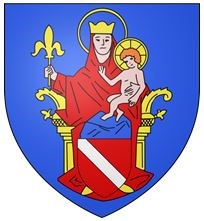

Rouffach, cité de la Renaissance
Rouffach est l’ancienne capitale des possessions haut-rhinoises des princes-évêques de Strasbourg. Ces puissants seigneurs développèrent la ville en une véritable forteresse, entourée d’une double enceinte de murs, reliée à l’imposant château d’Isenbourg qui dominait la cité. La Renaissance marque l’âge d’or de Rouffach. Le riche patrimoine architectural de la ville témoigne des splendeurs passées. Nombreuses sont les marques de noblesse, d’attributs artisanaux et autres qui ornent les oriels ou les linteaux de portes. Malheureusement, la grande majorité de ceux-ci a été mutilée lors de la Révolution française. Rouffach est la ville de la pierre. Le matériau roi est le fameux grès jaune exploité dans les carrières du Strangenberg dès l’époque romaine et qui fut utilisé pour la construction des principaux monuments de la région. L’habitat est caractérisé par les caves pratiquement de plain-pied pour parer aux inondations. En général, le logis se trouve à l’étage pour éviter l’humidité. Intéressantes sont les « communautés de cour », c'est-à-dire les regroupements de plusieurs maisons autour d’une cour commune accessible par un porche. Un système surtout intéressant par le gain de place à l’intérieur de l’enceinte de la ville. En flânant par les rues et ruelles, l’amateur de vieilles pierres découvrira ces résidences patriciennes à oriel, ces maisons vigneronnes aux porches armoriés qui forment un ensemble plein de charme et du plus grand intérêt.
Rouffach, Renaissance Stadt
Die Vergangenheit von Rouffach verliert sich im Dunkel der Zeiten. Die latinisierte Ortsbezeichnung „Rubeacum“ lässt auf eine keltische Niederlassung schliessen. Die Römerzeit ist durch kürzliche Funde im alten Ortskern besonders gut belegt. Die Merowinger Könige erbauten hier eine ihrer Residenzen: die Isenburg. Seit der Reichsteilung unter den Erben Karls des Grossen gehörte die Gegend mit dem Elsass bis zum 30 jährigen Krieg zum Heiligen Römischen Reich. Im 7. Jahrhundert kam die Domäne von Rouffach an die Fürstbischöfe von Strassburg, welche von da an bis zur französischen Revolution ihre weltlichen Landesherren blieben. Der Sage nach übergab König Dagobert der II. die Domäne an Strassbourg aus Dankbarkeit für die durch Bischof Arbogast wundersam erwirkte Heilung des verunglückten Königssohnes Siegbert. Die strassburger Bischöfe bauten die Stadt zur Festung mit doppelter Umwallung aus. Rouffach wurde Hauptverwaltungsort ihrer Besitzungen am Oberrhein, dem Oberen Mundat. Adlige, Ministeriale, religiöse Gemeinschaften und Handwerkerzünfte trugen zum Ruhm der Stadt bei. Die Renaissance war Rouffachs goldene Zeit. Das bauliche Erbe bezeugt den damaligen Wohlstand der Bischofsstadt. Der Kunst- und Geschichtsfreund entdeckt beim Wandeln durch unsere Strassen und Gässchen all die Patrizier- und Bürgerhäuser, die Winzerhöfe und Kleinbürgerwohnungen (Hintersassen), welche einen reizvollen und hoch interessanten Baubestand bilden.
Rouffach, city of the Renaissance
The origin of Rouffach most probably goes back to the Celtic period. The Latin name of the place was "Rubeacum". Excavations in the centre of the early town show that the Romans settled down in Rouffach. The Merovingian built here one of their residences: the Isenbourg. Until the end of the Thirty Years' War, the area of Rouffach was part of the Holy Roman Empire. In the 7th century, Rouffach became the property of the Prince Bishops of Strasbourg until the Revolution. The legend attributes this donation to King Dagobert the 2nd after the miraculous resurrection of his son Sigebert thanks to the intercession of Bishop Arbogast of Strasbourg. The Bishops of Strasbourg transformed the town into a real fortress, with a double surrounding wall joining the castle Isenbourg which still overlooks the town. Rouffach became the capital of their Upper-Rhine possessions, the "Upper Mundat" constituted by the bailiwicks of Rouffach, Soultz and Eguisheim. Nobles, religious communities and guilds contributed to the splendour of the town. The Renaissance characterizes the golden age of Rouffach.
Parking: N 47° 57.380 E 007° 18.020
Q1 / Church: N 47° 57.413 E 007° 18.040
The spire rises on the transept (former bell tower) and is called "the finger of the city". How many sides do you count ? =A
Q2 / Guild: N 47° 57.397 E 007° 17.957
At nr 4. This house was the headquarter of a guild. An inscription from the year 1583 is on the façade. The ensign on the lintel was hammered during the revolution. Which animal do you see ?
- a wolf, B=10
- an elephant, B=20
- an owl, B=30
Q3 / Witches tower: N 47° 57.327 E 007° 17.973
This tower is the last fortified tower of the town. The circular base is the oldest part from the 13th century. The tower was used as a jail for hundreds of years. During the Inquisition, the so called "witches" were imprisoned there that's why the tower is called "witches tower". How many crenels are there on the top of the tower ? =C
Q4 / Storks park: N 47° 57.345 E 007° 18.097
How do you say storks in French ?
- la cigognette, D=10
- le cigognon, D=20
- la cigogne, D=30
Q5 / Old well: N 47° 57.422 E 007° 18.150
This well, with shields on the lintel, comes from the property from the noble family Knechtlin / Kirtz. Which date can you read ? =E
Q6 / Saint John of Nepomuk: N 47° 57.463 E 007° 18.143
This statue from the bridges' patron recalls the former drawbridge situated at the same place. What are the attributes of this saint ?
- a cross and the Bible, F=10
- the martyr's crown and a crucifix, F=20
- a sword and a shield, F=30
Q7 / House of the "Three Ladies": N 47° 57.440 E 007° 18.065
This house from the 16th century is called "Three Ladies", because of the oak pillars supporting the overhang. How many pillars are there ? =G
The treasure: Bravo ! You've answered all the questions. Now you can find the treasure !
N47° 57.Nord E7° 18.Est
Nord=(E/G)-F-35
Est=(A+B+C+D)+27